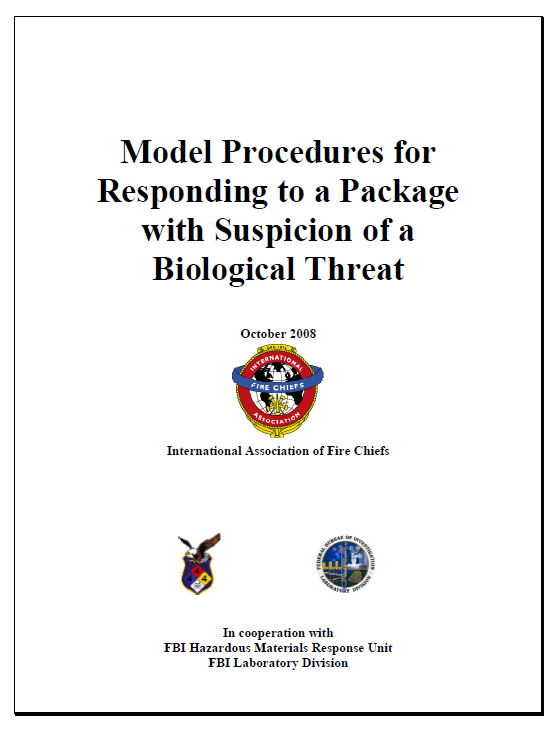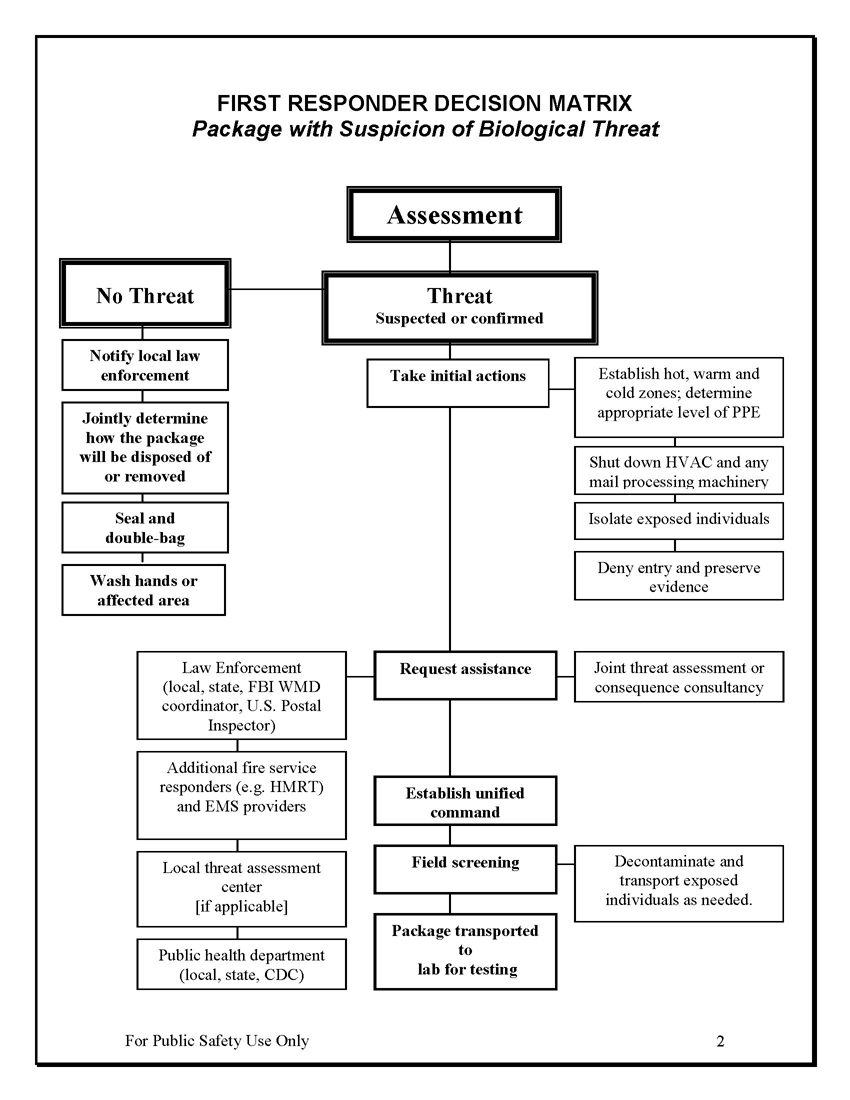 International Association of Fire Chiefs
International Association of Fire Chiefs
- FBI Hazardous Materials Response Unit
- 20 pages
- For Public Safety Use Only
- October 2008
I. Introduction
Local and world events have placed the nation’s emergency service at the forefront of homeland defense. The service must be aware that terrorists, both foreign and domestic, are continually testing the homeland defense system.
In October 2001, a person or persons contaminated the U.S. mail stream with anthrax, resulting in illness and death. The potential threat of similar attacks continues, and the authorities continue to be called in to assess hoaxes and suspect materials. No community is immune from the threat. To protect the health and safety of the public, and to help deal with hoaxes and suspicious materials, clear procedures for assessing and managing biological threats are imperative.
Departments of all sizes should have procedures in place to determine the credibility of and manage a potential threat. To date, emergency service agencies across the nation have taken independent action to address these needs. However, the action ranges from cursory attention to fully developed, detailed response procedures. The following model procedure, based on sound principles, complements the concepts of unified command, promotes interoperability and generates standard operating guidelines that all departments will recognize.
The International Association of Fire Chiefs developed these guidelines in coordination with local emergency responders and federal authorities, as noted in Appendix E of this document.
II. Purpose
The purpose of these guidelines is to provide a model procedure for first-arriving emergency service personnel for addressing potential bioterror events primarily involving suspicious letters, packages or containers.
This model provides a framework for building a local protocol tailored to a specific community. It was created to serve as a model for all types of fire departments in all types of communities. While some information may reach
beyond the typical scope of the first responder, it is outlined so that a first responder will have knowledge of the broader process in which they may be requested or required to assist.
…
Definition of a package: A letter, box, jar, suitcase or any other container that may hold a suspect material.
…
…
VIII. RESPONDER PROCEDURE:
IF THE ANSWER TO ANY ASSESSMENT QUESTIONS IN SECTION VI. IS “YES”1. If they are not already on the scene, notify local law enforcement. Establish a unified command with the lead emergency service agencies. Ensure all special called agencies (e.g., federal law enforcement, certified bomb squad, health department, etc.) are included in the unified command structure.
2. Request special assistance (e.g., certified bomb squad, decontamination units, state and federal authorities, etc.) as soon as a threat requiring their involvement is identified.
3. Control the scene.
a. Establish hot, warm and cold zones. The size of the hazard control zones should be based on the assessed threat. Depending on the scenario, the initial hot zone may range from the desk top in an office to an entire building depending on the situation. Use barrier tape to cordon off open areas.
b. Shut down the building ventilation system if there has been a substance release.
c. Turn off any high-speed mail processing equipment that may have handled the suspicious package.
d. Isolate those who have been exposed or potentially exposed and consider shelter-in-place as an initial tactical consideration. Do not evacuate the building unless an immediate threat is evident. Individuals, including emergency service personnel, who contacted the package must be assessed for the need for decontamination (See Section IX., level of decon may vary from washing with soap and water, to full gross decon.) and transport to the hospital. Only under extreme medical emergency conditions should a contaminated victim be transported prior to decontamination. Contaminated immediate need victims must be placed in a protective envelope (e.g., Tyvek® suit) to minimize secondary contamination of the general population and/or environment.
e. Consider location and well-being of those unexposed or unlikely exposed. Non-victims may need to be gathered together for law enforcement interviews, or to receive information from public health or other officials to inform and allay fears.

